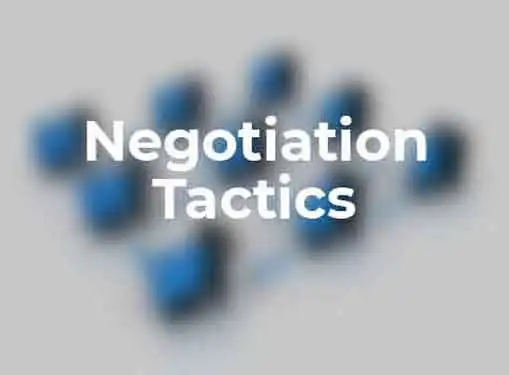Negotiations
Negotiation Tactics
A successful negotiation strategy is executed through a series of proven negotiation tactics. Here are some of the essential tactics business leaders use to gain the upper hand.
It's difficult to underestimate the value of a good negotiator.

First-rate negotiators consistently achieve targeted outcomes, even when the odds are stacked against them. For a small business, negotiating skills are invaluable because they level the playing field and make it easier to compete with more established firms.
The good news is that negotiation is a learned skill set. Some personalities are more conducive to negotiating skills than others, but for the most part, anyone can learn how to become a good negotiator through training, effort, and experience. One of the most valuable investments your company can make is to require company leaders to attend a reputable negotiation training program.
But when everything is said and done, the outcomes of negotiations often boil down to negotiation tactics - the decisions, actions, and techniques that are employed during the negotiation process. Negotiators who have a firm grasp on techniques usually have the upper hand, especially when they know how to properly utilize a handful of essential tactics.
- Segmentation. Segmentation (also known as fragmentation) lets you negotiate one issue at a time. Instead of negotiating one large issue, you negotiate several smaller issues, isolating the impact of a problem area on other negotiations.
- Shifting responses. If possible, force the other person to quantify the offer. Rather than countering an offer with a specific dollar value, you can suggest that the offer is still too low and effectively force the other person to offer a second dollar figure that may be higher than you had hoped for.
- Adding small concessions. It's possible to nickel and dime your way to negotiation success by tacking on requests for a small concession. Although they may seem negligible, small concessions can add up over the course of a long negotiation.
- Averaging. Averaging or splitting the difference is a common way for negotiators to reach agreement. If the negotiation appears to be headed toward middle ground, you can inflate your interest as a way to end up on the higher end of the average.
- Taking it off-the-table. If negotiations seem to stall out on a specific issue, take the issue off the table. It's often more advantageous to return to a trouble spot later, after you have reached agreement on other point.
- Bluffing. Good negotiators regularly bluff at critical points in the process. It's a risky strategy, but if you're adept at it, bluffing can manipulate the negotiation in your favor.
- Walk away. Successful negotiators are know when it's time to walk away from negotiations. In some cases, a walk away opens the door for concessions and a fast resolution to the process.
Share this article
Additional Resources for Entrepreneurs



Conversation Board
We greatly appreciate any advice you can provide on this topic. Please contribute your insights on this topic so others can benefit.